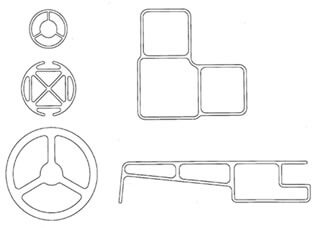Aluminum’s low-density, high-strength profile makes it an ideal material for OEM products that need to be lightweight and strong. But with hundreds of different alloy options, choosing the correct material for aluminum extruding can be confusing.
In the design phase, OEM engineers often choose the most cost effective aluminum alloy available. But defaulting to lowest price without considering how the material reacts to extruding and surface finishing can jeopardize the final product.
Engineers who work closely with their aluminum extruders in the design phase to understand the technical variations of each alloy are better equipped to choose the alloy that offers the right combination of strength, weight and cost for their specific project.
6000 Series Aluminum Alloys
The 6000 series of alloys tends to be the most popular class of aluminum alloys for extrusion. Made of magnesium and silicon, these alloys are easy to form, machine and finish. The mechanical strength and ability to withstand corrosion makes this aluminum alloy series a common choice for structural applications like solar panel racking and mounting systems, marine recreational apparatus’ and medical equipment.
As the mechanical properties – tensile strength, density, ductility, formability, workability, weldability and corrosion resistance – within the 6000 series increase, the finish appearance can suffer and the ability to extrude the alloy diminishes.
For many applications, 6063 is one of the most cost-effective alloys available. This alloy’s heat tolerance, strength and smooth surface make it a popular choice for window and door-frames, tubing, and heat sinks.
Another popular alloy for aluminum extrusion is 6060. With strong corrosion resistance, formability and weldability, it is designed for maximum extrudability. Alloy 6060 allows for more intricate extrusion profiles with slightly better heat transfer – making it a good alternative alloy for heat sink profiles.
Alloys 6061 and 6005A have some of the highest mechanical properties in the 6000 series. The 6061 alloy is common for multi-purpose uses, as it is highly weldable and combines strength with good corrosion resistance. This alloy is often used to make components for boats, firearms and medical equipment. The 6005A alloy has similar characteristics to 6061, and in many cases, it is a more appropriate alloy due to its better extrudability and surface appearance.
Table: Ratings for mechanical properties, surface quality and roughness, and extrudability for the 6000 series of alloys.

Increasing the mechanical properties has an impact on the ability to produce a thin, lightweight extrusion. The 6063 alloy, for example, allows 25-35% thinner walls than 6061.
Leaner alloys, such as 6060 versus 6063, or 6005A versus 6061, allow you to extrude thinner walls or more complex shapes but still obtain the same minimum mechanical properties of their comparable alloys. Your alloy choice also can restrict the extrusion’s final shape.
Below are some examples of extruded shapes designed for strength. On the left, center webs have been added as a load point of the extrusion. On the right, the extrusions are designed to have a profile shape to take on the higher stress of a certain area.

Various treatments of the alloys can produce different properties. The temper designations T1-T10 identify artificial aging temper and other processes such as stretching and compressing.
To make the most informed decision, work with the engineering resources at your aluminum extruder. Selecting the right alloy for your application will optimize your end product’s design and development goals for high strength, light weight, and low cost.
